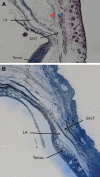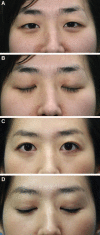Double-eyelid surgery using septoaponeurosis junctional thickening results in dynamic fold in asians
- PMID: 25289207
- PMCID: PMC4184050
- DOI: 10.1097/GOX.0b013e318293dc69
Double-eyelid surgery using septoaponeurosis junctional thickening results in dynamic fold in asians
Abstract
Background: To avoid a static double-eyelid fold characterized by nonmobile overdepression of the fold, we propose a new surgical approach of using septoaponeurosis junctional thickening (SAJT) to create a dynamic fold.
Methods: Six hundred eighty patients underwent double-eyelid surgery using the SAJT fixation technique. The orbital septum was exposed and transversely opened superior to the incision margin. The lower septal stump was trimmed to expose the SAJT. The dermis and orbicularis oculi muscle of the lower flap of the upper eyelid were attached to the SAJT. Patients were followed for 2-8 years (mean, 3.6 y). Anatomic study with 28 upper eyelids from 28 Korean adult cadavers was performed to confirm the histological structure of the SAJT.
Results: This technique created a dynamic fold. When the eyes were open, the fold depth was moderate. When the eyes were closed, the fold site was smooth and not depressed. The surgery had a 95% patient satisfaction rate (365 responded as satisfied and 236 responded as very satisfied). Postoperative complications included partial or complete loss of the double-eyelid line in 14 and 4 cases, respectively, hypertrophic scar formation in 7 cases, and asymmetric fold in 8 cases.
Conclusions: The authors introduce a double-eyelid surgery technique using the SAJT. This SAJT fixation technique creates a dynamic double-eyelid fold. Our study showed a high patient satisfaction rate and that the resulting fold mimics the movement of the congenital supratarsal fold in Asians.
Figures











References
-
- Chen W PD. Asian Blepharoplasty and the Eyelid Crease. 2nd ed. New York, NY: Elsevier; 2006.
-
- McCurdy JA. Cosmetic Surgery of the Asian Face. New York, NY: Thieme Medical Publishers; 1990.
-
- Kikkawa DO, Kim JW. Asian blepharoplasty. Int Ophthalmol Clin. 1997;37:193–204. - PubMed
-
- Chen W PD. In: In: Cosmetic Oculoplastic Surgery. Putterman AM, editor. Philadelphia, PA: WB Saunders; 1999. pp. 101–111.
-
- Jeong S, Lemke BN, Dortzbach RK, et al. The Asian upper eyelid: an anatomical study with comparison to the Caucasian eyelid. Arch Ophthalmol. 1999;117:907–912. - PubMed
LinkOut - more resources
Full Text Sources
Other Literature Sources
